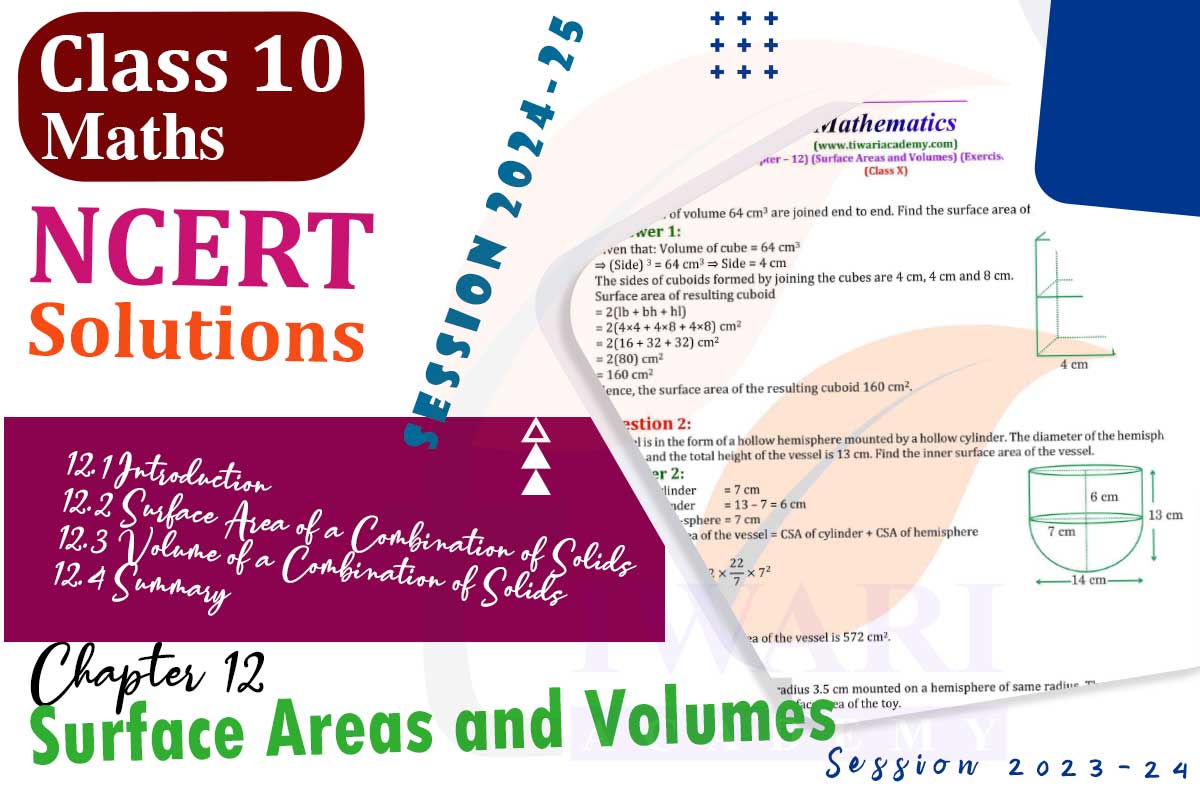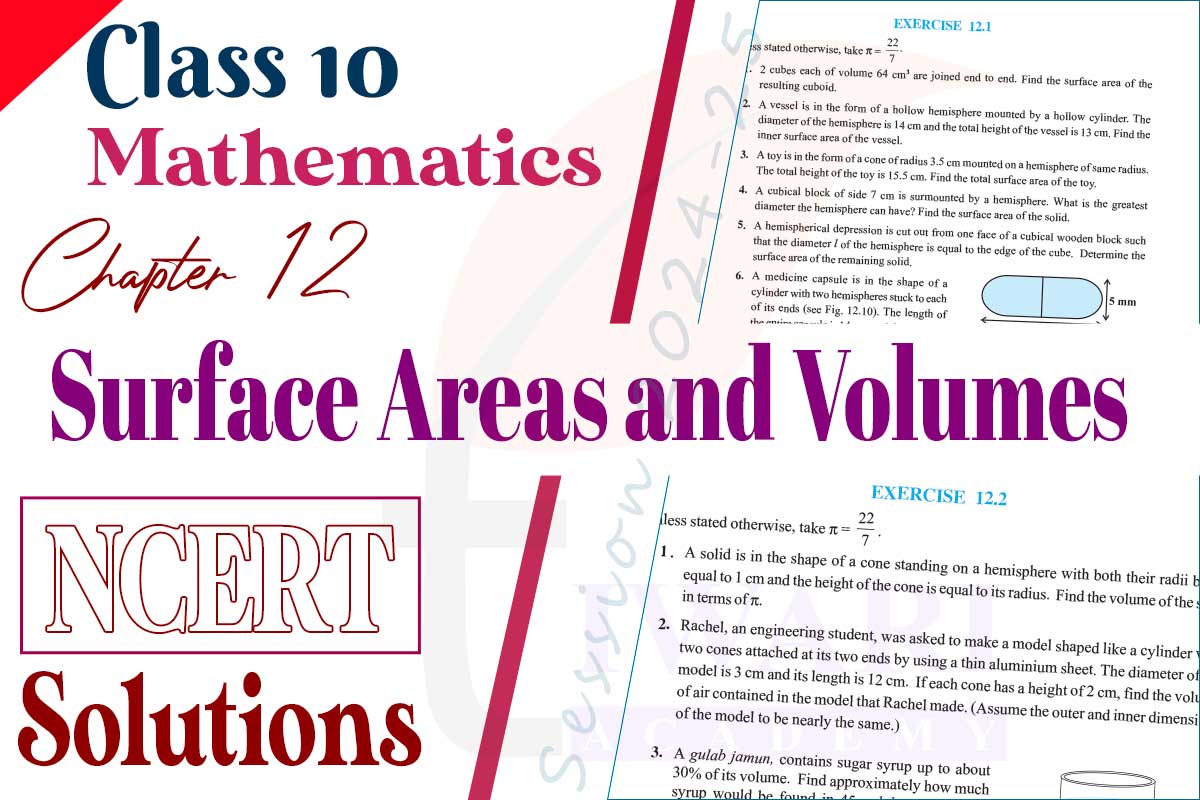Revised NCERT Solutions for class 10 Maths Chapter 12 Surface areas and volumes in Hindi and English Medium updated for session 2024-25. As per the new syllabus and NCERT Books published for academic year 2024-25, there are only two exercises in chapter 12 of 10th mathematics.
NCERT Solutions of Class 10 Maths Chapter 12 for CBSE Board
Class 10 Maths Exercise 12.1 in English
Class 10 Maths Exercise 12.2 in English
Class 10 Maths Exercise 12.1 in Hindi
Class 10 Maths Exercise 12.2 in Hindi
Class 10 Maths Chapter 12 Solutions for State Boards
Class 10 Maths Exercise 12.1
Class 10 Maths Exercise 12.2
Class 10 Maths Exercise 12.3
| Class: 10 | Mathematics |
| Chapter 12: | Surface areas and volumes |
| Content: | NCERT Textbook Exercises |
| Content Type: | PDF, Images, Text and Videos |
| Session: | CBSE 2024-25 |
| Medium: | English and Hindi Medium |

Class 10 Maths Chapter 12 all exercises (Ex. 12.1 and Ex. 12.2) for all boards. We have updated all the contents for new academic session 2024-25. UP Board students are now using NCERT Textbooks for their course and exams, so they can download UP Board Solutions for Class 10 Maths Chapter 12 all exercises from the links given below. Contents are applicable for UP Board 2024-25 and CBSE Board in Hindi and English medium. Contents are free in PDF format to download without any login or registration. Download NCERT Solutions Online and Offline App for session 2024-25 based on updated NCERT Solutions and latest NCERT Books 2024-25. Previous year CBSE Exam question, important questions for practice are also given below. Download and practice to score good marks and solve your doubts easily.
10th Maths Chapter 12 Solutions
CBSE NCERT Solutions for class 10 Maths Chapter 12 Surface areas and volumes exercises 12.1 and 12.2 are given here to free download in PDF or view online without downloading. All the solutions are updated for new academic session 2024-25 for UP Board, MP Board, Gujrat, CBSE board, etc., who are using latest NCERT Books for course.

Previous Years Questions
ONE MARK QUESTIONS
1. Volume and surface area of a solid hemisphere are numerically equal. What is the diameter of hemisphere? [CBSE 2017]
THREE MARKS QUESTIONS
1. A metallic solid sphere of radius 10.5 cm is melted and recast into smaller solid cones, each of radius 3.5 cm and height 3 cm. How many cones will be made? [CBSE 2017]
FOUR MARKS QUESTIONS
1. In a hospital used water is collected in a cylindrical tank of diameter 2 m and height 5 m. After recycling, this water is used to irrigate a park of hospital whose length is 25 m and breadth is 20 m. If the tank is filled completely then what will be the height of standing water used for irrigation the park. Write your views on recycling of water. [CBSE 2017]
2. The height of a cone is 30 cm. From its topside a small cone is cut by a plane parallel to its base. If volume of smaller cone is 1/27 of the given cone, then at what height it is cut from its base? [CBSE 2017]
3. The height of a cone is 10 cm. The cone is divided into two parts using a plane parallel to its base at the middle of its height. Find the ratio of the volumes of the two parts. [CBSE 2017]
Objective of Surface areas and volumes
1. To identify situations where there is a need of finding surface area and where there is a need of finding volume of a solid figure and to find the surface areas & volumes of cuboids, cubes, cylinders, cones spheres and hemispheres, using their respective formulae. To solve some problems related to daily life situations involving surface areas and volumes of above solid figures.
2. In this chapter, we will deal with problems such as finding the area of sheet to covers a solid body, area of an object which is combination of two objects, finding the number of one object, required for creating another different object, finding the cost of ploughing a given field at a given rate, finding the cost of constructing a water tank with a particular capacity, finding area & volume of frustum (Frustum is a Latin word meaning ‘piece cut off’ and its plural form is ‘Frusta’) and the conversion of one solid into another solid on the basis of volume and so on.
For solving above type of problems, we need to find the perimeters and areas of simple closed plane figures (figure which lie in a plane) and surface areas and volumes of solid figures (figures which do not lie wholly in a plane). You are already familiar with the concepts of perimeters, areas, surface areas and volumes. In this chapter, we will study these in details.
Historical Facts! about Surface Areas and Volumes
Archimedes of Syracuse, Sicily, is remembered as the greatest Greek mathematician of the ancient era. He contributed significantly in geometry regarding the areas of plane figures and the areas and volumes of solid figures. He proved that the volume of a sphere is equal to two-third the volume of a circumscribed cylinder.
What are the topics to study in chapter 12 Surface Areas and Volumes of 10th Maths?
In chapter 12, Surface Areas and Volumes of class 10 math, students will study
- Surface Area of a Combination of Solids.
- Volume of a Combination of Solids.
- Conversion of Solid from one shape to another.
Which topics students should revise before starting chapter 12 of class 10 Maths?
Before starting chapter 12 of class 10 Maths, Students should revise all the formulas mentioned in chapter 12 (surface areas and volumes) of class 9th Maths.
Is there any optional exercise in chapter 12 of class 10th Maths?
Yes, there are no optional exercise in chapter 12 of class 10th Maths. Exercise 13.2 is challenging because this exercise contains logical questions which require higher-order thinking skills. Students find this exercise a little complex as compared to other exercises of this chapter.
Is chapter 12 of class 10th math difficult to solve?
Chapter 12 of class 10th Maths is not easy and not difficult. It lies in the middle of easy and difficult because some examples and questions of this chapter are easy, and some are difficult. However, the difficulty level of anything varies from student to student. So, Chapter 12 of class 10th Maths is easy or not depends on students also. Some students find it difficult, some find it easy, and some find it in the middle of easy and difficult.


